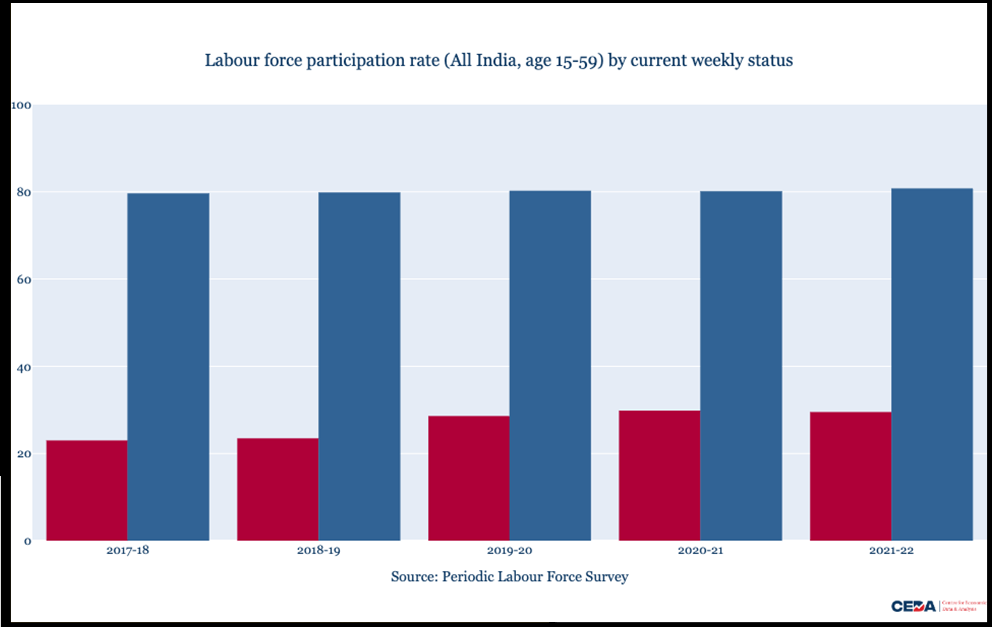INDIA’S SUBOPTIMAL USE OF ITS LABOUR POWER
Syllabus:
GS 3:
- Indian Economy and issues relating to planning, mobilization, of resources, growth, development and employment.
Focus:
- The economy continues to engage a majority in low quality work, which has larger macroeconomic growth repercussions.
Source:- The wire
India’s labor market is characterized by a vast informal sector, encompassing around 90% of its workforce. This segment, marked by precarious job conditions, lack of social security, and low earnings, poses significant challenges to economic growth and the realization of the demographic dividend. Understanding and addressing the complexities of informal employment is crucial for India’s path to sustainable development.
Overview of Employment in India
- Predominance of Labor Income: Most Indians earn their income through labor rather than capital or land.
- High Informal Employment: Approximately 90% of the workforce is in informal jobs lacking security and benefits.
- Concentration of Informal Workers: Informally employed are mainly casual laborers and the self-employed, including some regular wage earners.
- Vulnerability of Informal Workers: They face low earnings, no social protection, and precarious job conditions.
- Segmentation in Employment: Informal employment spans across various sectors, impacting a significant portion of the workforce.
Economic Impact and Labor Market Dynamics
- GDP and Living Standards: The labor market’s condition directly influences GDP growth’s impact on living standards.
- Rising Labor Force Participation: LFPR increased from 52.35% in 2017-18 to 58.35% in 2021-22, driven by rural women.
- Decreasing Unemployment Rates: Overall unemployment fell from 6.2% to 4.2% between 2017-18 and 2021-22.
- Youth Unemployment Trends: Despite high rates, youth unemployment shows a decreasing trend.
- Dependency on Labor Market Health: The economic well-being of the masses hinges on job creation, job quality improvement, and wage growth.
Job Quality and Earnings Insights
- Self-Employment as a Driver: Self-employment, especially among unpaid family workers, primarily fuels LFPR growth and unemployment reduction.
- Rise of Unpaid Family Labor: Significant growth in unpaid family labor, with a slight increase in self-employed employers.
- Stagnation in Earnings: No real earnings increase for the self-employed, highlighting income insecurity.
- Deteriorating Job Quality: The growth in self-employment points to a worsening of work quality.
- Varied Employment Growth: Despite an overall increase in worker numbers, earnings have stagnated across most employment types.
Broader Economic Implications
- Low Productivity Concerns: A majority engaged in low productivity work challenges optimal labor capital utilization.
- Impact on Consumer Demand: Stagnant earnings, especially among the poor, could weaken consumer spending.
- Demographic Dividend Challenges: India’s inability to capitalize on its demographic dividend due to suboptimal labor engagement.
- Vicious Cycle of Low Investment: Stagnant demand and declining investment to GDP ratio threaten to perpetuate economic slowdown.
- Urgent Need for Quality Jobs: Enhancing job quality and earnings is crucial for leveraging the demographic dividend effectively.
Way forward
Vocational Training:
- Establish recognising/accrediting agencies for vocational training institutes to optimize and empower India’s labor workforce.
- Develop a framework to interlink vocational training and academic education, facilitating movement between streams for students and trainees.
Social Security:
- State governments should enact legislation for the welfare of unorganized workers, clearly identifying resources, benefits, and institutional mechanisms.
- Provide welfare services such as compensation for work-related accidents, death, and old-age pensions in the ‘risk cover mode.’
Employment Information Service:
- Offer employment information services through e-governance to support initiatives providing employment guarantees in backward districts.
- Ensure dissemination of employment opportunities from both private and public sectors to the lowest levels.
Integrating Problem Solving with a Forward-Looking Approach:
- While many provisions in the Codes address past demands and discrepancies, a forward-looking approach is needed.
- Address future challenges such as automation, robotics, AI-powered workforces, and bioengineering to safeguard workers’ rights.
The predominance of informal employment in India underscores a critical challenge to the nation’s economic health and social welfare. Transitioning this vast workforce into formal employment realms is imperative for boosting job quality, ensuring social security, and propelling India towards inclusive and sustainable economic growth. Strategic interventions, policy reforms, and inclusive development programs are essential to facilitate this transition, ultimately leading to a more resilient and equitable economy.
| In 2020, Parliament enacted 4 Labour Codes to streamline and replace 29 sets of labor regulations, with all four receiving presidential approval. These codes became effective from July 1, 2022.
The four labor codes are: Code of Wages Act 2019: · Aims to implement minimum wages and labor reforms by replacing outdated laws. · Supervises wages and bonus payments in all employment locations. · Guarantees the “Right to Sustenance,” universalizes minimum wage requirements, and ensures prompt payment of wages. · Empowers the central government to set minimum wages. · Subsumes laws such as The Payment of Wages Act, 1936; Minimum Wages Act, 1948; Payment of Bonus Act, 1965; and Equal Remuneration Act, 1976. Social Security Code Bill, 2020: · Proposes a National Social Security Board to advise on programs for unorganized, gig, and platform workers. · Requires gig worker aggregators to make social security contributions of 1% to 2% of annual revenue. Occupational Safety, Health, and Working Conditions Code Bill, 2020: · Defines interstate migrant workers earning up to Rs. 18,000/month. · Distinguishes between regular and contractual employment. · Proposes journey allowance instead of temporary housing for employees near workplaces. Industrial Relations Code Bill, 2020: · Requires industrial establishments with 100+ employees to specify employment terms. · Extends the requirement to establishments with 300+ employees. · Introduces new prerequisites for lawful strikes, including arbitration proceedings. · Suggests establishing a fund for reskilling laid-off workers supported by employers. |
Source:
https://epaper.thehindu.com/reader
Mains Practice Question:
“Examine the impact of informal employment on India’s economic growth and labor market dynamics. Discuss the strategies that can be employed to transition the workforce from informal to formal employment, enhancing job quality and security.”




